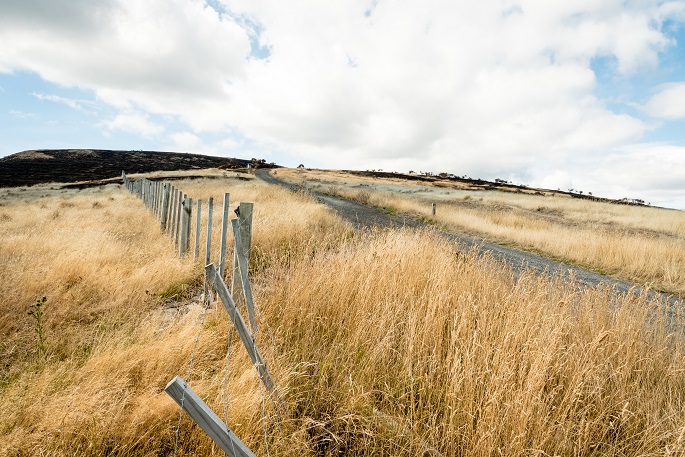With elevated fire danger levels predicted in certain regions until the end of April, researchers at Scion are calling for greater public awareness about the hazard posed by tinder dry grasses.
The fire hazard posed by cured - dry brown - grass is quick ignition and a fast-moving fire.
The fire season is generally October to March but dry conditions in northern and eastern parts of the North Island, Wairarapa, Marlborough, Canterbury and Otago are keeping fire authorities on alert.
Dry conditions have created low soil and fuel moisture levels and, with high pressure favoured for at least the first half of April, these same parts of the country are expected to further cure, or brown off, grass.
As curing increases, the moisture content decreases further, making grass easier to ignite and more likely to burn with higher rates of spread and intensity.
Fire and Atmospheric Science Team researcher Shana Gross says it is important for the public to know that dry grasses are still highly flammable at this time of year, even though temperatures have dropped.
“Grass is one of the most common fuels in New Zealand,” says Shana.
“It’s super abundant and can ignite quickly, spreading fast. People need to think about grasses, tussock, and grazed and ungrazed pasture (that is dry and/or isn’t irrigated), as a potential fire hazard and be aware of the elevated risk to property and lives when grass is very dry.”
Scientists at Scion have been studying the behaviour of wildfire in New Zealand for decades, analysing how different fuels behave and spread under various conditions.
 Rank grass on the Port Hills in 2017 with scorched land in the background. Photo: Supplied.
Rank grass on the Port Hills in 2017 with scorched land in the background. Photo: Supplied.
Over the past 30 years, data shows that most wildfires in New Zealand started in grass fuels. Of the 50,097 wildfires recorded, 40,736 or 81 per cent of wildfires started in dry grass.
Typically, grasses and scrub fuels will dry out first in the fire season and become a hazard earlier than large fuels, such as trees. These fuels are likely to remain hazardous over much of the fire season and even sometimes through the winter.
Although grass fires are typically less intense and shorter-lived than forest fires, they can spread exponentially faster, outrun firefighting resources and put more property and lives at risk.
Based on the predicted weather conditions for the next couple of weeks, a grass fire could spread 8km per hour on the flat and even faster uphill.
“Of all the fuel types, fires travelling in grass fuels are a major cause of firefighter injuries or fatalities due to people underestimating how fast-moving grass fires can travel,” says Shana.
Education plays a pivotal role in reducing fire risks, with Scion advocating for public awareness and proactive measures that encourage people, especially in rural areas or in semi-rural subdivisions, to think twice before engaging in activities that could generate sparks near cured grass, such as mowing tall brown grass which can cause a spark and ignite a fire. Best practice is to reduce activities that creates sparks.
“Anyone cutting through stubble or long grass using mowers, chainsaws or brushcutters needs to be aware about the current fire danger level and other conditions before starting. Fire and Emergency New Zealand (FENZ) provides a handy website to make checking easy,” says Shana.
There have been several high-profile grass and vegetation fires in the 2023-24 wildfire season. In January near Kirwee west of Canterbury, kilometres of grass and scrub burned next to the railway line, disrupting train services and threatening homes and farmlands.
That same month, a large blaze also burned through about 10ha of vegetation, including grass, in Loburn near Rangiora, destroying two houses, a converted church, 10 sheds, and a number of cars and machinery.
On February 14, a major vegetation fire started in dry grass and spread rapidly on the Port Hills in Christchurch, burning 650ha, destroying a container home and forcing the evacuation of nearby residents. A local state of emergency remained in place for five weeks.
With the fire danger remaining high across Canterbury, residents have again been cautioned to avoid high-risk activities that could generate sparks, as well as instructions to park vehicles away from long grass as hot exhausts can also start a fire in tinder dry grass.
As more people build closer to farmland in the rural-urban interface, Scion social scientist Lisa Langer says it becomes even more important for people to be aware of the fire hazard of grass.
“Expanding residential housing on the boundary of our towns and cities comes with exposure to the wildfire hazard. Recognition of grass as a fire hazard is important so developers, planners, engineers and landscape architects can plan to effectively minimise risk for new subdivisions.”



0 comments
Leave a Comment
You must be logged in to make a comment.